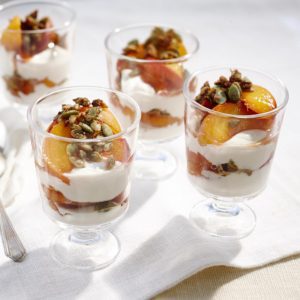Lately, fruit has been on the ‘Don’t eat list’. Many diet books have raised concern that the sugar and carbohydrate in fruit can prevent weight loss or even make you fat.
So is this true? It may be true if fruits are ingested in excessive amounts. For example, ingesting a dozen apples provides 1140 Calories! But eating an excessive amount of fruit is the exception: most people don’t eat enough fruits and need to increase their fruit intake.
A high fruit intake may help prevent heart disease, stroke, high blood pressure, cancer, cataracts, macular degeneration, and type 2 diabetes. Fruit is a good source of fibre, potassium, vitamin C, and folate – all nutrients that defend against disease. Along with those nutrients, fruit also provides carbohydrates, in the form of a sugar called fructose. Because of this sugar content, fruit contains more calories than vegetables: one cup of blueberries has 21 grams of carbohydrate and 84 calories, while one cup of broccoli has only 6 grams of carbohydrate and 30 calories.
DO YOU NEED TO LIMIT YOUR FRUIT INTAKE?
There are some individuals who would benefit from limiting their fruit intake. When attempting to lose weight, excessive fruit consumption may contribute to a higher calorie intake. Thus 2-4 servings of fruit per day is sufficient for someone who is trying to lose weight. People who have diabetes, or prediabetes (also known as impaired fasting glucose) may need to limit fruit intake to control blood sugar levels. And lastly, if a person’s blood triglyceride levels are high, fruit may need to be limited as fruit can further exacerbate this problem. While fruit intake may need to be limited for these individuals, intake of fruits does not need to be avoided altogether.
ARE ALL FRUITS CREATED EQUALLY?
Fruits that have a low glycemic index (fruits that release their sugar gradually, rather than quickly, into the blood) and fruits that are high in fructose should be avoided.
Most fruits have a low glycemic index with the exception of fruits like bananas, dates, raisins, watermelon and cantaloupe – which have a high glycemic index. Fruits high fructose should be avoided because excessive consumption can promote fat production in the liver and can cause blood triglycerides to increase significantly. Fruits that are low in fructose include cantaloupe, grapefruit, oranges, strawberries, peaches, nectarines, and bananas. Thus, not all fruits are created equally.
HOW MUCH FRUIT SHOULD YOU EAT?
Health Canada recommends that adults consume 7-10 servings of fruits/vegetables per day, where about ½ of these servings should be fruits, and ½ of these servings should be vegetables. One serving of fruit equals 1 medium sized fruit, ½ cup of berries or fresh cut up fruit, ¼ cup dried fruit, or ½ cup of 100% fruit juice. Limit intake of fruit juice to one serving/day as fruit juice lacks fibre and doesn’t contribute to satiety.
The following are suggestions for increasing fruit intake if fruit intake is low:
- Ingest fruit as a snack and keep fruit visible to encourage healthy snacking.
- Make a smoothie with fruit
- Substitute fruit for a high calorie sweet treat
- Add fruit to green and whole grain salads
- Eat frozen fruit or pre-cut fresh fruit

Spice Roasted Peach and Yogurt Parfaits
6 Portions
Preparation Time: 15 min
Cooking Time: 20 min
Fruit and yogurt get special treatment in this dessert. Fragrant spices and a touch of sugar, along with roasting the peaches, add intense flavour and the spiced, glazed seeds add crunch. Layered with vanilla-perfumed thick and creamy yogurt and you’ve got a parfait fit for company, yet easy enough for every day.
Ingredients
| 3 tbsp | packed brown sugar | 45 ml |
| 1/2 tsp | ground cinnamon | 2 ml |
| 1/4 tsp | ground ginger | 1 ml |
| Pinch ground allspice | ||
| 3 | large peaches, cut into 1/2-inch (1 cm) wedges | |
| 1/2 cup | unsalted sunflower and/or pumpkin seeds | 125 ml |
| 2 cups | plain Greek yogurt | 500 ml |
| 1 tsp | vanilla extract | 5 ml |
The peaches can be roasted up to 8 hours ahead. Let cool, then cover and store at room temperature until assembling the parfaits. The seeds can be toasted up to 3 days ahead; once cooled, store in a cookie tin at room temperature. The parfaits are best assembled just before serving.
Substitute 3 large black or red plums for the peaches; they may require about 5 minutes longer baking time depending on the firmness of the fruit.
Instructions
Step 1
Preheat oven to 400°F (200°C). Line a small baking sheet with parchment paper.
Step 2
In a small bowl, combine sugar, cinnamon, ginger and allspice.
Step 3
Place peaches in an 8-inch (20 cm) square glass baking dish; sprinkle with half of the sugar mixture and toss gently to coat. Spread in a single layer. Roast for about 15 to 20 minutes or until peaches are tender and lightly browned. Let cool slightly, or to room temperature.
Step 4
Meanwhile, in a small skillet, toast sunflower seeds and/or pumpkin seeds over medium heat, stirring constantly, for about 3 minutes or until starting to turn golden; add remaining sugar mixture cook, stirring, for about 2 minutes or until toasted and glazed. Spread out onto parchment paper and let cool.
Step 5
To assemble, in a bowl, combine yogurt and vanilla. Divide half of the yogurt equally among 6 dessert dishes and top with half of the roasted peaches, then half of the glazed seeds; repeat layers.
Nutrition & Notes
Nutrition Information
Valeur nutritive
Per 1 cup Serving
Calories / Calories 175
Fat / Lipides 6 g
Saturated / saturés
+ Trans / trans
Cholesterol / Cholestérol
Sodium / Sodium 33 mg
Carbohydrates / Glucides 21 g
Fiber / Fibres 2.7 g
Sugars / Sucres
Protein Protéines 11 g
Recipe provided by Dairy Farmers of Canada.
